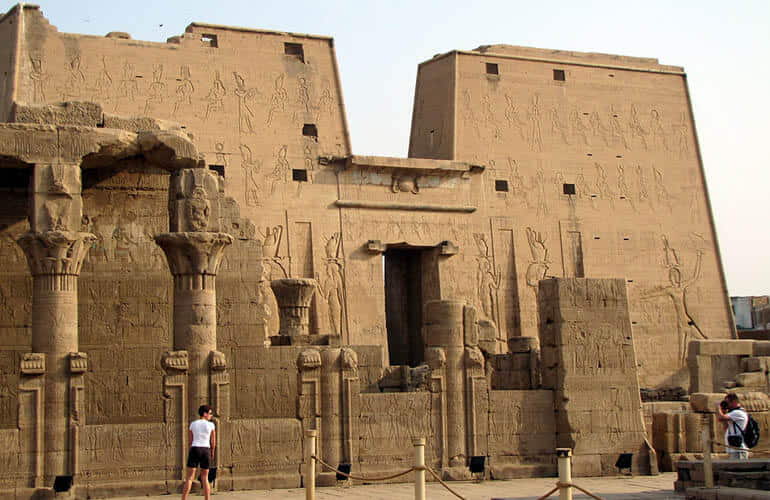Temple of Edfu facts
Temple of Edfu. Dedicated to the falcon god Horus [ Read more about Eye of Horus], it is the best-preserved temple in Egypt and the most important after the Temple of Karnak. It measures 137 meters long by 79 meters wide and 36 meters high. It represents the typical construction of the temples with the pylon.

Temple of Edfu Location
The temple of Edfu, located in the city of the same name (Edfu) is situated on the west bank of the Nile, 115 km south of Luxor and 105 km north of Aswan. It is a stopping place for most of the Nile cruise sailing the Nile river. is one of the four temples and places where the events of the legend of Osiris, Isis, and Horus take place. Son of the god Ra. The temple is dedicated to the falcon god Horus.
The architecture of the Temple of Edfu
The temple of Edfu maintains the classical structure of the Greco-Roman period, beginning with the pylon, followed by a courtyard and the building of the pronaos or hypostyle room. Next was the naos of the sanctuary, which led to the Sanctum sanctorum of the temple, where the statue of the temple deity Horus in this case, was located. In 1798, during Napoleon’s campaign in Egypt, the temple was buried some twelve meters below the desert sand. It did not see the light of day again until 1860.
The temple of Edfu fell into disuse as a religious building after the edict of Theodosius I which forbade non-Christian worship within the Roman Empire in 391 AD. As in other places, many of the carved reliefs of the temple were razed to the ground by the Christians who came to dominate Egypt. The blackened ceiling of the hypostyle hall, still visible, is believed to be the result of arson to destroy religious images that were considered pagan at the time.
The pylon of Edfu temple, 36x74m, is only surpassed by Karnak. On both sides of the access door, there are four slots, where in the past masts were erected with banners, in front of the pylon walls. Then you enter the large courtyard, surrounded by columns. At the end of it, before the entrance to the great hypostyle hall, there are two imposing falcons, 3.2m. high, crowned with the double crown of Upper and Lower Egypt. The falcon on the left is in a great state of conservation, except for the painting it would originally have had, which would surely give it a colossal image.
After leaving the falcons, we enter the great hypostyle hall, supported by 18 monumental columns. The columns, the ceiling, and the walls are extraordinarily decorated. On the ceiling, there were astronomical representations, while the walls have images of the Ptolemaic monarchs. Next, there is a second hypostyle room, the anteroom of the sanctuary where the sacred boat and the granite monolith that housed the golden image of the god Horus were located.
Edfu is a true source of knowledge about the sacred world of Pharaonic Egypt. The translation of the texts carved in Hieroglyph on the walls, columns, and ceilings of Edfu temple makes it possible today to approach Egypt with more direct and concrete elements when investigating the unknown fruits of Ancient Egypt.
You can book the excursion to the Temple of Edfu combined with the visit to the Temple of Kom Ombo at the best price directly through discovering our day trip to Luxor and Aswan day trips with the best private tours of Egypt from Cleopatra Egypt Tours.






